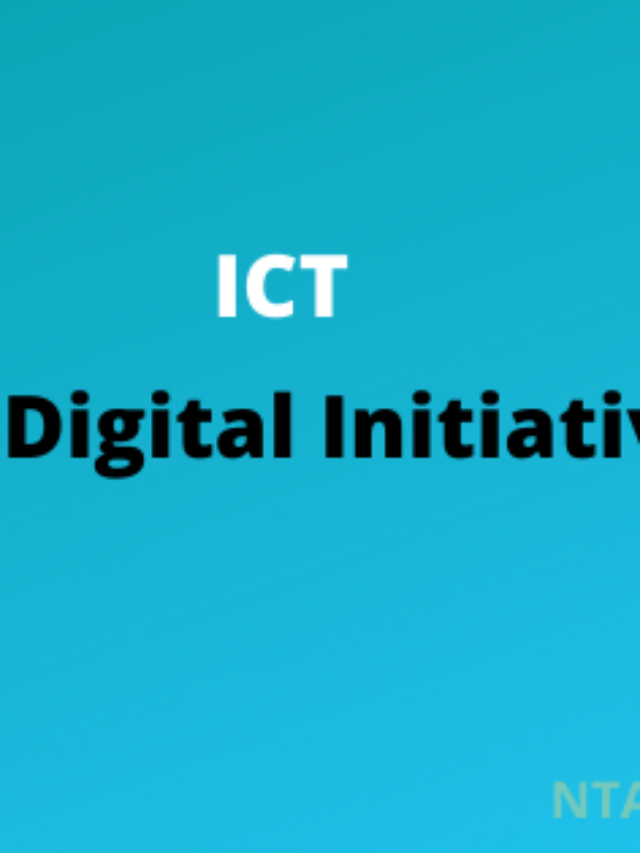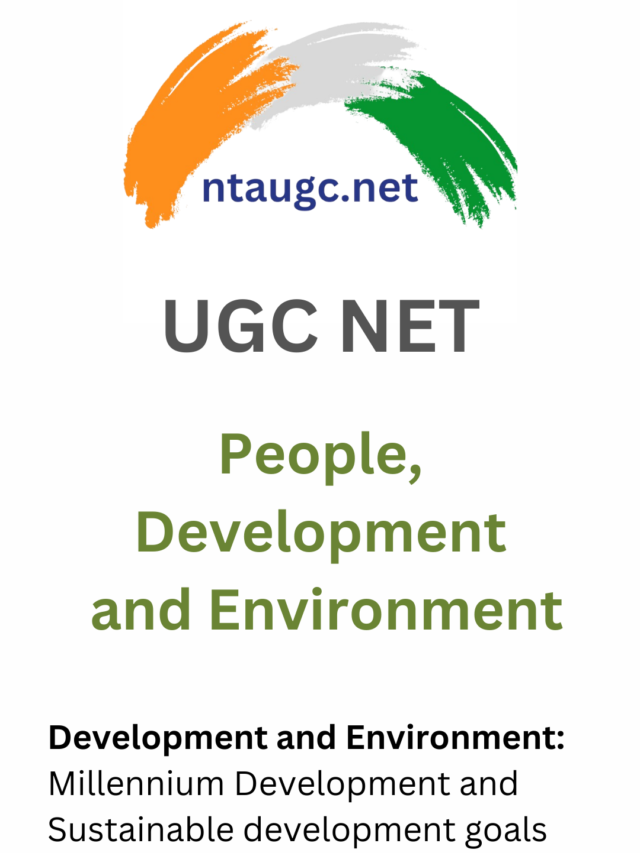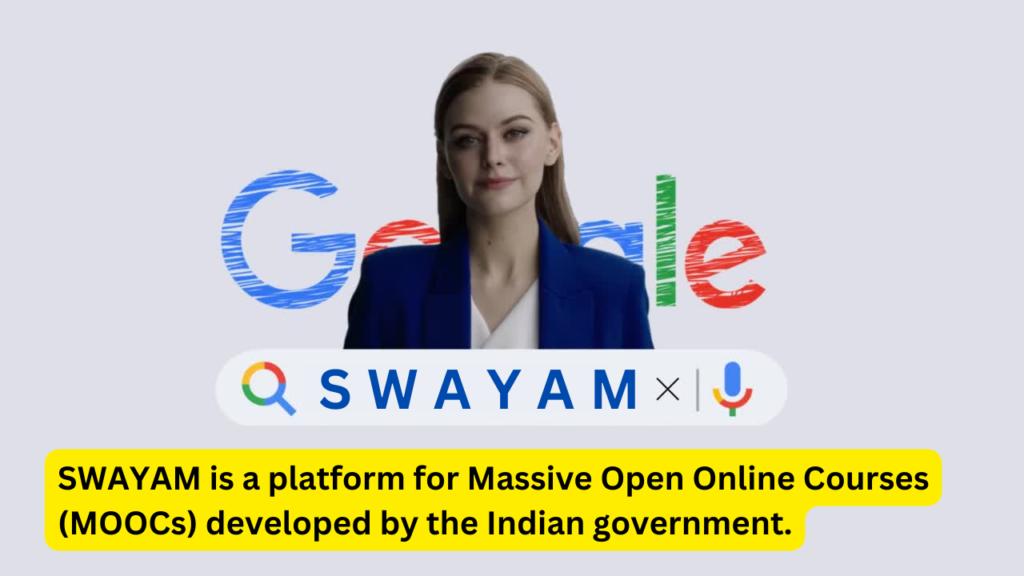ICT (Digital Initiatives)
There are various educational initiatives launched by MHRD and the Government of India. Some of these initiatives are listed below.
UGC
- The University Grants Commission (UGC) came into existence on 28th December 1953 became a statutory Organization of the Government of India by an Act of Parliament in 1956.
- It was established for the coordination, determination, and maintenance of standards of university education in India.
- In order to ensure effective region-wise coverage throughout the country, the UGC has decentralized its operations by setting up six regional centers at Pune, Hyderabad, Kolkata, Bhopal, Guwahati, and Bangalore.
Gyan Vani:
- Gyan Vani (GV) was conceived in 2001 as a network of educational FM Radio Channels operating from various cities (Allahabad, Bangalore and Coimbatore) in the country to enhance and supplement the teaching-learning process suited to the educational developmental and socio-cultural needs of the local community.
- The term ‘Gyan’ stands for knowledge and ‘Vani’ stands for aerial broadcasting.
- Gyan Vani stations offer day-to-day programmes contributed by different Educational Institutions, NGOs and national level institutions like IGNOU, NCERT, UGC, IIT, etc.
- Each station has a range of about 60-km radius, covering the entire city/town plus the surrounding environs with extensive access.
- Gyan Vani’s main intention is to take education to the doorsteps of the people.
- It also deals with awareness programmes including the ones for Panchayat Raj Functionaries, Women Empowerment, Consumer Rights, Human Rights, the Rights of the Child, Health Education, Teacher Education, Non-formal Education, Adult Education, Education for the handicapped, Education for the downtrodden, education for the tribal and so on.
Gyan Darshan
- Launched by the MHRD, Information & Broadcasting, the Prasar Bharti and IGNOU jointly on 26th January 2000
- It is a 24-hour transmission channel for educational programmes which covers a variety of subjects and catering to a wide range of viewers.
Gyan Dhara
- It is an internet audio counselling service offered by IGNOU, where the students can listen to the live discussions by the teachers and experts on the topic of the day and interact with them through telephone, email and also chat mode.
GIAN
- Global Initiative of Academic Networks (GIAN) in Higher Education, which is an initiative by MHRD, was launched in 2015.
- It aims at improving the quality of higher education and elevating India’s scientific and technological capacity to global excellence through international collaboration.
- Hence, it can be concluded from the given points that Gyan Vani is an educational FM radio network.
E-Pathshala
- It is a joint initiative of the Ministry of Human Resource Development (MHRD), Govt. of India, and National Council of Educational Research and Training (NCERT).
- It is developed for showcasing and disseminating all educational e-resources.
- It includes textbooks, audio, video, periodicals, and a variety of other digital resources.
- Pathshala mobile app is designed to achieve the Sustainable Development Goals as well i.e. equitable, quality, inclusive education, and lifelong learning for all and bridging the digital divide.
- It is a portal app developed by CIET, NCERT, and can be accessed on the Web and is available on Google Play, App Store, and Windows. The content is available in English, Hindi, and Urdu.
- Students, Teachers, Educators, and Parents can access eBooks through multiple technology platforms like mobile phones and tablets (as epub) and from the web portal through laptops and desktops (as Flipbook).
- Features of these books allow users to pinch, select, zoom, bookmark, highlight, navigate, share, listen to text using text to
- speech (TTS) apps, and make notes digitally.
Saransh
- It is developed by CBSE and is successfully launched by HRD minister Smriti Zubin Irani in National Conference on ICT in school education held on November 07, 2015, at Vigyan Bhawan.
- It helps schools and parents to review student’s performance in various subjects.
- Analysis based on data empowers schools and parents to make the best decision for students.
- It helps the school to look at performance in scholastic areas at an aggregate level and at the level of each student.
- Facilitates interaction between Parents and Schools so that they can monitor the progress of students and help them improve their performance.
- All the performance metrics are presented through numbers as well as in charts/ graphs for easy understanding.
Shaala Siddhi
- The National Programme on School Standards and Evaluation (NPSSE), known as Shaala Siddhi.
- It is developed by the National University of Educational Planning and Administration (NUEPA).
- It is a comprehensive instrument for school evaluation leading to school improvement.
- It aims to evaluate the individual school and its performance in a holistic and continuous manner leading to school improvement in an incremental manner.
- Its major objective is to develop a technically sound conceptual framework, methodology, instrument, and process of school evaluation to suit the diversity of Indian schools.
Study Webs of Active – Learning for Young Aspiring Minds (SWAYAM)
- It is a programme initiated by the Government of India and designed to achieve the three cardinal principles of Education Policy viz., access, equity and quality.
- The objective is to take the best teaching-learning resources to all, including the most disadvantaged.
- It seeks to bridge the digital divide for students who have previously remained untouched by the digital revolution and have not been able to join the mainstream of the knowledge economy.
- The courses hosted on SWAYAM are in 4 quadrants, such as video lectures, specially prepared reading material that can be downloaded/printed, self-assessment tests through tests and quizzes and an online discussion forum for clearing the doubts.
- The learning experience has been enriched by using audio-video and multi-media and state of the art pedagogy/technology.
- To ensure best quality content are produced and delivered, seven National Coordinators have been appointed: They are NPTEL for engineering, UGC for post-graduation education, CEC for under-graduate education, NCERT & NIOS for school education, IGNOU for out of the school students and, for management studies.
- Courses delivered through SWAYAM are interactive, prepared by the best teachers in the country and are available free of cost to the learners, however, learners wanting a SWAYAM certificate should register for the final exams that come at a fee and attend in-person at designated centres on specified dates.
SWAYAM PRABHA
- It is an Initiative by MHRD to provide education by the medium of Television Channels.
- It is a group of 34 DTH channels devoted to telecasting of high-quality educational programs on a 24×7 basis using the GSAT-15 satellite.
- Every day, it telecast new content for at least 4 hours which is repeated 5 more times in a day, allowing the students to choose the time of their convenience.
- All the channels are uplinked from BISAG, Gandhinagar.
- The contents are provided by NPTEL, IITs, UGC, CEC, IGNOU, NCERT, and NIOS.
- The INFLIBNET Centre maintains the web portal.
Indira Gandhi National Open University (IGNOU).
- IGNOU was founded to serve the Indian population by means of distance and open education, providing quality higher education opportunities to all segments of society.
- It also aims to encourage, coordinate and set standards for distance and open education in India, and to strengthen the humar resources of India through education.
- Apart from teaching and research, extension and training form the mainstay of its academic activities.
- It also acts as a national resource center and serves to promote and maintain standards of distance education in India.
- Gyan Darshan (GD) channel is a major milestone in the field of Educational Television in India.
- It is a joint venture of the Ministry of Human Resource Development (MHRD), Ministry of Information & Broadcasting (I & B Ministry), Prasar Bharati, and IGNOU serving as the nodal agency.
- Launched in the year 2000, GD is a 24-hour educational channel that offers the best educational programs covering a variety of subjects and catering to a wide range of viewers.
- IGNOU was entrusted with the responsibility of national coordinator for five channels of SWAYAM PRABHA, the DTH channel initiative of the Government of India.
CBSE
- Central Board of Secondary Education (CBSE) was constituted in the year 1962.
- To define appropriate approaches of academic activities to provide stress-free, child-centered, and holistic education to all children without compromising on quality.
- To analyze and monitor the quality of academic activities by collecting the feedback from different stakeholders
- To develop norms for implementation of various academic activities including quality issues.
NCTE
- The National Council for Teacher Education (NCTE) as a statutory body came into existence in pursuance of the National Council for Teacher Education Act, 1993 on the 17th August 1995.
- The main objective of the NCTE is to achieve planned and coordinated development of the teacher education system throughout the country.
National Institute of Technical Teachers Training and Research (NITTTR):
- National Institute of Technical Teachers’ Training and Research, Chennai (or NITTTR) is an autonomous educational institution under the Ministry of Education (MoE) (Formerly Ministry of Human Resource Development or MHRD), Government of India
- Four National Institutes of Technical Teachers’ Training and Research (NITTTRs) are located at Bhopal, Chandigarh, Chennai, and Kolkata
- NITTTR Chennai is one of the National Coordinator for the SWAYAM MOOC project of MHRD
- NITTTR Chennai is coordinating online courses for the teachers training program
- NITTTR was established in the mid-1960s for the training of polytechnic teachers to undertake activities in the areas of Education, Planning & Management, Curriculum Development for implementation and Research, etc. for the overall improvement of polytechnic education.
- The Institutes offer long-term training programs of 12/18 months duration to degree and diploma level teachers of Polytechnic in addition to providing short-term training courses, designing of curriculum and providing consultancy services to the industry
DigiLocker
- Digital Locker is one of the key initiatives of the Ministry of Electronics & IT (Meity) under the Digital India Programme.
- It is aimed at minimizing the usage of physical documents and enable sharing of e-documents across agencies.
- The citizens can access their documents anytime and anywhere irrespective of their physical location.
- It is also aimed at the concept of paperless governance by reducing the administrative overhead by minimizing the use of paper and curtailing the verification process.
- It also ensures the authenticity of the e-documents and thereby eliminate the usage of fake documents.
National Mission on Education through Information and Communication Technology (NMEICT)
- It has been envisaged as a Centrally Sponsored Scheme to leverage the potential of ICT, in the teaching and learning process for the benefit of all the learners in Higher Education Institutions.
- This was expected to be a major intervention in enhancing the Gross Enrolment Ratio (GER) in Higher Education by 5 percentage points during the XI Five Year Plan period.
- The three cardinal principles of Education Policy viz., access, equity, and quality could be served well by providing connectivity to all colleges and universities, providing low cost and affordable access-cum-computing devices to students and teachers, and providing high-quality e-content free of cost to all learners in the country.
- It seeks to bridge the digital divide, i.e. the gap in the skills to use computing devices for the purpose of teaching and learning among urban and rural teachers/learners in the Higher Education domain
- It seeks to empower those who have so far remained untouched by the digital revolution and have not been able to join the mainstream of the knowledge economy.
- It plans to focus on appropriate pedagogy for e-learning, providing the facility of performing experiments through virtual laboratories, online testing and certification, on-line availability of teachers to guide and mentor learners, utilization available Education Satellite (EduSAT) and Direct to Home platforms, training, and empowerment of teachers to effectively use the new method of teaching-learning, etc.
Unified Mobile Application for New-age Governance (UMANG)
- It is developed by the Ministry of Electronics and Information Technology (Meity) and National e-Governance Division (NeGD) to drive Mobile Governance in India.
- It enables users to access all government services through a single mobile interface.
- UMANG provides a single platform for all Indian Citizens to access pan India e-Gov services ranging from Central to Local Government bodies and other citizen-centric services.
Bharat Interface for Money (BHIM)
- It is a payment app that lets you make simple, easy, and quick transactions using Unified Payments Interface (UPI).
- Unified Payments Interface (UPI) is an instant payment system developed by the National Payments Corporation of India (NPCI), an RBI regulated entity.
- UPI allows one to instantly transfer money between any two parties’ bank accounts.
- It led to the development of the BHIM by the National Payments Corporation of India (NPCI).
- BHIM is a mobile payment application that can be used by anyone who has a bank account with a linked mobile number and was launched by the Prime Minister Narendra Modi on 30 December 2016.
eBiz
- Ministry of Commerce and Industry, in 2013, announced to launch eBiz, India’s first Government-to-Business (G2B) portal
- eBiz is being implemented by Infosys Technologies Limited (Infosys) under the guidance of the Department of Industrial Policy and Promotion (DIPP), Ministry of Commerce & Industry, Government of India.
- The focus of eBiz is to improve the business environment in the country by enabling fast and efficient access to Government-to- Business (G2B) services through an online portal.
- This aims at reducing the points of contact between business entities and Government agencies in various regulatory processes required to start and run businesses.












